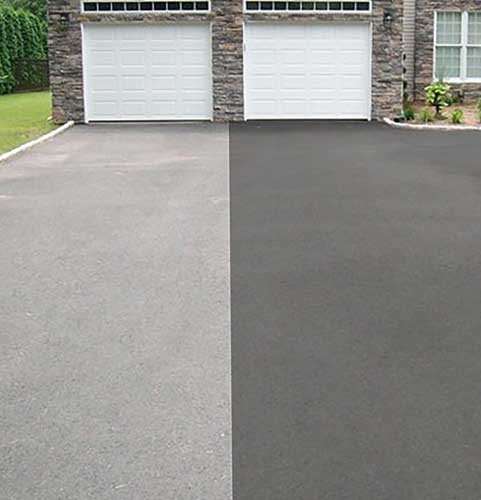Effective Asphalt Repair: Cold Mix Sealing Techniques Revealed
Wiki Article
Cold Mix Asphalt Vs. Hot Mix Asphalt: Which Is Right for You?

Composition Distinctions
Cold mix and hot mix asphalts vary considerably in their make-up, with distinct attributes that influence their performance and applications. Cold mix asphalt is created by emulsifying the asphalt binder with water and an emulsifying representative before mixing it with accumulation. This approach permits the asphalt to be convenient at reduced temperature levels, making it excellent for short-term repair services and for usage in colder climate condition. Warm mix asphalt, on the various other hand, is manufactured at high temperatures, commonly in between 300-350 ° F, which helps to accomplish far better compaction and a more resilient end product. The warm mix asphalt production procedure entails heating up the aggregate and asphalt binder separately prior to incorporating them at the asphalt plant.
In addition, cool mix asphalt tends to be less thick and extra adaptable than warm mix asphalt. This adaptability makes it far better matched for locations with greater levels of movement, such as driveways or roads with rush hour. In comparison, warm mix asphalt is recognized for its high durability and resistance to rutting and splitting, making it a preferred choice for freeways and high-traffic roadways where durability is vital.
Setup Process Variances
The process of mounting chilly mix and hot mix asphalt exhibits notable differences in their requirements and procedures. Cold mix asphalt, being an extra versatile material, can be used straight from the bag or container onto the fracture or harmed area. It calls for very little preparation work, such as cleaning the area and condensing the chilly combine with hand tools. This makes it a hassle-free alternative for quick and short-lived repairs. In contrast, warm mix asphalt requires a more intricate setup process. It entails heating up the mixture to heats before laying it down on a correctly ready base. The preparation consists of compacting the base, using a tack coat, and making use of heavy equipment like pavers and compactors for a durable and smooth coating. Due to the home heating requirements, warm mix asphalt installations are commonly performed by specialists with specific tools, guaranteeing an extra permanent and structurally sound outcome.Durability and Longevity Aspects
When thinking about asphalt choices, resilience and longevity are crucial factors to review for enduring pavement efficiency. Warm mix asphalt (HMA) is known for its exceptional durability and long life.
In terms of longevity, HMA commonly outshines CMA because of its superior toughness and resistance residential or commercial properties. HMA sidewalks have a longer life span, requiring much less frequent fixings and upkeep, which can equate to cost financial web savings over time. Additionally, HMA pavements are much more easily adjustable to meet certain project needs, further boosting their sturdiness.
Cost Factors To Consider
Thinking advice about the monetary effects is a critical facet when reviewing the selection in between warm mix asphalt (HMA) and cool mix asphalt (CMA) for pavement jobs. While the preliminary cost of warm mix asphalt is generally higher than that of cool mix asphalt, HMA often supplies a much more economical service in the long run due to its remarkable longevity and long life.In enhancement to product expenses, it's important to think about the costs connected with installation and upkeep when contrasting HMA and CMA. HMA typically requires specialized tools and knowledgeable labor for appropriate installation, which can impact total job costs. Alternatively, CMA is less complicated to function with and can frequently be used making use of easier techniques, possibly lowering installment expenditures. Ultimately, the choice between HMA and CMA should take into consideration not just the initial expense but additionally the long-lasting economic ramifications to determine one of the most affordable alternative for the certain pavement job.
Environmental Influence Contrast
Comparison of the ecological impacts in between hot mix asphalt (HMA) and cold mix asphalt (CMA) reveals unique distinctions in sustainability methods. HMA manufacturing needs high temperature levels, leading to enhanced power usage and greenhouse gas discharges.Moreover, using CMA typically entails reusing existing asphalt sidewalk, promoting source preservation and reducing the quantity of waste sent out to landfills. This recycling element further boosts the sustainability of CMA contrasted to HMA. Overall, when considering the ecological impact, CMA emerges as a much more environmentally sustainable selection due to its reduced power requirements, reduced emissions, and the possibility for reusing existing materials. By selecting CMA over HMA, roadway building jobs can add see it here positively to environmental preservation initiatives.
Final Thought
In conclusion, the option in between cool mix asphalt (CMA) and hot mix asphalt (HMA) relies on various aspects such as composition, installment procedure, sturdiness, durability, price, and ecological effect. angle parking. While CMA supplies a cost-effective and fast service for minor repairs, HMA makes certain remarkable longevity and longevity for rush hour areas. Think about these elements meticulously to establish which kind of asphalt is the ideal option for your paving requires

Taking into consideration the monetary implications is an essential aspect when assessing the choice between warm mix asphalt (HMA) and cold mix asphalt (CMA) for pavement projects. While the preliminary price of hot mix asphalt is commonly greater than that of chilly mix asphalt, HMA often gives a much more economical solution in the long run due to its premium sturdiness and durability. angle parking.Contrast of the ecological effects between hot mix asphalt (HMA) and chilly mix asphalt (CMA) reveals distinctive differences in sustainability practices.In final thought, the choice in between cold mix asphalt (CMA) and warm mix asphalt (HMA) depends on numerous aspects such as structure, installation procedure, resilience, longevity, price, and ecological influence
Report this wiki page